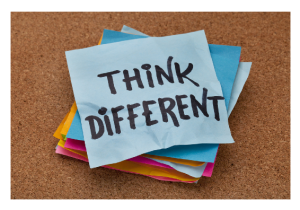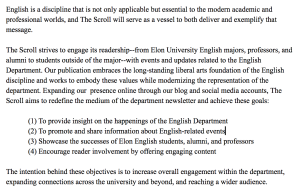Guest Blogger Jordan Stanley ’17
 This Spring semester, the CUPID studio class embarked on revitalizing the English Department newsletter. In doing so, we translated the ideas behind the Back Cover (the old newsletter) to The Scroll, the new multimodal newsletter that shares the happenings of the English department across the mediums of Facebook and Instagram accounts and a blog. In creating a new publication—whether it is a transfer of medium, management, or starting from the ground up—there are many aspects that must be taken into consideration. While this can include seemingly endless facets—from deliverables, multiple chapters of a style guide, roles within the new publication, and more—many of the assignments that our class had to complete could be boiled down into two overarching categories: the abstract and the technical. My role in the development of the new English department newsletter revolved largely around the former.
This Spring semester, the CUPID studio class embarked on revitalizing the English Department newsletter. In doing so, we translated the ideas behind the Back Cover (the old newsletter) to The Scroll, the new multimodal newsletter that shares the happenings of the English department across the mediums of Facebook and Instagram accounts and a blog. In creating a new publication—whether it is a transfer of medium, management, or starting from the ground up—there are many aspects that must be taken into consideration. While this can include seemingly endless facets—from deliverables, multiple chapters of a style guide, roles within the new publication, and more—many of the assignments that our class had to complete could be boiled down into two overarching categories: the abstract and the technical. My role in the development of the new English department newsletter revolved largely around the former.
When our CUPID studio class decided exactly what was that we wanted out of The Scroll, our ideas were by no means singular. Of the things we wanted The Scroll to accomplish, there was (1) what we wanted The Scroll to embody, (2) what content we wanted to bring to the audience, (3) what audience we wanted to reach, and (4) how. Objectives #2-4 are largely under the technical category, although the brainstorming that brought us to these objectives was certainly abstract. I like to think that I participated heavily in this abstract section of our preparation—offering ideas for how to shape our undertaking and the message that we wanted The Scroll to send (modern, new, not the same old newsletter). Before we talked about medium and content, we had to talk about the impression we wanted The Scroll to leave on its audience and its legacy, and then we were able to decide which media/content would allow us to arrive at that message. It was that abstract approach—and by abstract, I mean conceptual and somewhat idealistic—that I used to create #1 of those objectives: the mission to draw interns to The Scroll.
 Hannah W. and I collaborated on writing the mission statement and intern flyer, both of which balance a focus between the conceptual and technical areas of the job. Although there is obvious importance to the intern flyer—getting someone to run the publication—it was the mission statement that served as the assignment that forced me to wrestle with the goals of the class, my own goals—both conceptual and tangible—and how both the intern and readers would digest these goals. As far as juggling perspectives went, my plate certainly felt full.
Hannah W. and I collaborated on writing the mission statement and intern flyer, both of which balance a focus between the conceptual and technical areas of the job. Although there is obvious importance to the intern flyer—getting someone to run the publication—it was the mission statement that served as the assignment that forced me to wrestle with the goals of the class, my own goals—both conceptual and tangible—and how both the intern and readers would digest these goals. As far as juggling perspectives went, my plate certainly felt full.
Hannah and I wanted to make sure that we communicated these items:
1) English is still a relevant discipline despite the value our society places on growingly technical education
2) This relevance and modernity will be embodied in the new medium of The Scroll
3) Elon English students, alumni, and professors are very successful
4) Good things are happenings in the Elon English Department.
Making sure this was done concisely and digestibly proved to be somewhat challenging. Because the word count of a mission statement is small, the importance of each word chosen is heightened. When we showed our end product to the class, Hannah and I had been slightly nervous because we had been tasked with speaking on behalf of the group with little group consultation first. The group was pleased overall, but we did spend 5-10 minutes discussing one instance of diction in the last line. This goes to show how crucial the wording of a mission statement is in accurately articulating the mission of any organization; and this is a further testament to the importance of a mission statement in general. A mission represents who/what an organization or publication is—it is an embodiment of the mindset, goals, and attitude. I believe what Hannah and I learned most in creating this embodiment is that co-authorship can be difficult—exercising a balance between your voice and the voice of those you represent—and that perhaps the most significant part of a mission statement is knowing how important it is to create a rhetorical framework for a rhetorical product. See our final mission statement below.


 Follow
Follow